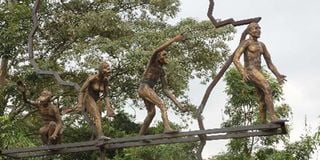Early Man fossils put Kenya on the global map at Smithsonian Folklife Festival

Sculptures of the human revolution outside the National Museum of Kenya. PHOTO/FILE
What you need to know:
- The Smithsonian bought the fossils from Kenya at $9,200 (Sh800,000) and they will remain in the US after the festival
- “Turkana Boy” was an important piece of evidence for the completeness of Early Man’s remains
WASHINGTON DC
Kevin Hicks is a voracious reader of books and journals on human origin and evolution.
For the last four years, the 12-yearl-old pupil at Takoma Park Elementary School in Montgomery County, Maryland, has been imagining how the skeleton of early humans looked like from his reading.
“I have also been wondering about the country where the Early Man lived because I’ve never seen him here (US),” he told the Nation at The National Mall on Friday, wearing an innocent look on his face.
His imagination became part of the history he loves reading Friday after coming face to face with replicas of the skeletons and skulls of archaic humans.
Kevin was among thousands of visitors who thronged the Kenyan “Search-for-Human-Origins” stand for lessons during the ongoing Smithsonian Folklife Festival in Washington DC, United States.
On display were replica skulls of 18-million-year-old Proconsul Heseloni, Australopithecus (4.1 million years old), Homo Rudolfensis (1.9 million years old) and Homo Habils (1.9 million years old). Others were 1.8-million-year-old Homo Erectus, Paranthropus Boisei (1.7 million years old) and Homo sapiens (300,000 years old).
The copies of the original skulls were arranged in the order of their evolution, with Proconsul Heseloni first and Homo Sapiens last. The original remains are kept and displayed in Kenya only.
The tools used by these early humans— including flakes, cores, hand axes and cleavers— were also on show by a group of scientists from the National Museums of Kenya, The Smithsonian Institution— the organisers of the festival— and several volunteers. The team also demonstrated how excavation is done using sand.
The Smithsonian bought the fossils from Kenya at $9,200 (Sh800,000) and they will remain in the US after the festival, according to Dr Fredrick Kyalo Manthi, the head of the Kenyan team at the stand.
Anthropology experts and students spent longer time at the stand, examining the remains and asking questions.
Many were impressed by Kenya’s rich record of human evolution, with some saying they would visit Turkana, Rusinga Island, Koobi Fora and other archeological sites to carry out research.
“All of us in the world are Kenyans and Africans in some sense,” Alison Brooks, 69, a professor at George Washington University, said.
“Kenya is a wonderful place to do research… it’s very well organized… I’m leaving on Sunday with one of my students and we’ll be working at the museum for the rest of the summer.”
The eyes of many visitors were glued to 1.6-foot tall skeleton of Homo Erectus, with many asking questions and taking selfies with it.
The skeleton, popularly known as “Turkana Boy”, was discovered in 1984 by Kamoya Kimeu, a member of a team led by Dr Richard Leakey, at Nariokotome near Lake Turkana.
Sharri Clark, an archaeological anthropologist, said “Turkana Boy” was an important piece of evidence for the completeness of Early Man’s remains, which is oftentimes disputed.
“I would recommend Kenya as a destination for studying these things,” said the Harvard University PhD graduate.
Dr Manthi said the remains, especially “Turkana Boy”, had placed Kenya on the world map as the origin of humans.
“When we say Africa is the cradle of mankind, I think we can even zero in and say Kenyan because truly, Kenya has the richest and most complete fossil record in Africa and the world,” he said, adding that Kenya’s record dates back to 25 million years.
He said dozens of university students taking anthropology courses had expressed interest in carrying out their research in Kenya.
“Today, I have talked to more than 10 taking Master’s and undergraduate courses. Some have been asking where the sites are located,” said the senior research scientist and head of paleontology at National Museums of Kenya.
He said “Turkana Boy” should be used to market Kenya abroad, based on the interest his skeleton had elicited at the Smithsonian event.
“And Kenyans should be very proud of their county and its rich cultural and historical heritage... . More should pursue careers in anthropology, paleontology and archaeology. It’s unfortunate that most of this work is being done by people from outside,” he said.
The Smithsonian Festival is an annual 10-day event that draws over 1.5 million visitors to the heart of the US political capital.
It started on June 25 and its curtain will be brought down Sunday. The Kenyan government and the private sector paid a $1 million (Sh88 million) to The Smithsonian Institution as participation fee.
Kenya is the fifth African country, and the first in East Africa, to be featured in the prestigious festival of culture, food, music and dance.




